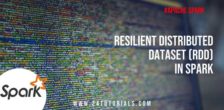DataFrame API
Spark 1.3 introduced a new DataFrame API as part of the Project Tungsten initiative which seeks to improve the performance and scalability of Spark. The DataFrame API introduces the concept of a schema to describe the data, allowing Spark to manage the schema and only pass data between nodes, in a much more efficient way than using Java serialization.
There are also advantages when performing computations in a single process as Spark can serialize the data into off-heap storage in a binary format and then perform many transformations directly on this off-heap memory, avoiding the garbage-collection costs associated with constructing individual objects for each row in the data set. Because Spark understands the schema, there is no need to use Java serialization to encode the data.
The DataFrame API is radically different from the RDD API because it is an API for building a relational query plan that Spark’s Catalyst optimizer can then execute. The API is natural for developers who are familiar with building query plans, but not natural for the majority of developers. The query plan can be built from SQL expressions in strings or from a more functional approach using a fluent-style API.
// SQL Style
df.filter("age > 21");
// Expression builder style
df.filter(df.col("age").gt(21));
Because the code is referring to data attributes by name, it is not possible for the compiler to catch any errors. If attribute names are incorrect then the error will only be detected at runtime, when the query plan is created.
Another downside with the DataFrame API is that it is very Scala-centric and while it does support Java, the support is limited. For example, when creating a DataFrame from an existing RDD of Java objects, Spark’s Catalyst optimizer cannot infer the schema and assumes that any objects in the DataFrame implement the Scala.Product interface. Scala case classes work out the box because they implement this interface.


